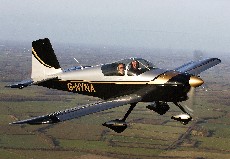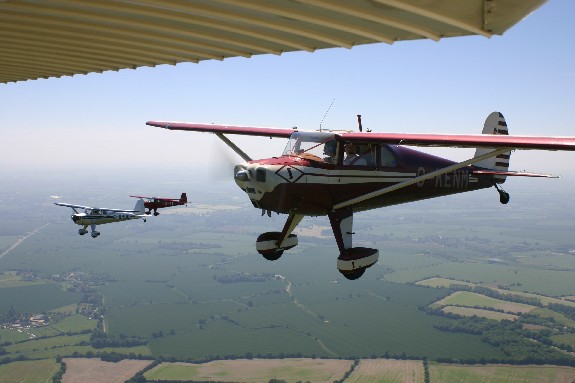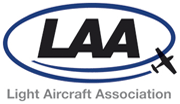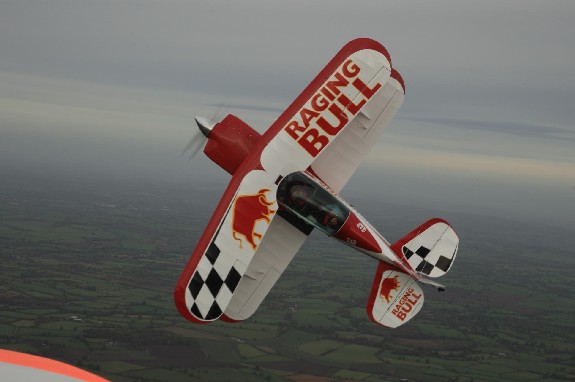
Vans RV 9a
In episode 51 of Flying Podcast I spoke to Andy Draper of the Light Aircraft Association about building your own aircraft. To get a broader appreciation of what the association does I was pointed in the direction of Brian Hope, editor of the LAA’s magazine ‘Light Aviation’.
First off I asked Brian to give me a potted history of the LAA. I knew that the group had previously been the PFA – Popular Flying Association – but I wasn’t aware that they’d had a previous incarnation.
According to Brian they were actually formed just after WWII as the Ultralight Aircraft Association and were tasked with looking after pilots who’d bought ex-RAF aircraft and those that were building pre-war planes such as the Luton Minor. He went on to explain that the French played a big part in the growth of home-building with the development of the VW air-cooled engine for use in aircraft.
The market continued to grow throughout the post war years with better kits from France and the US until the 1990’s which saw a rapid influx of new kits from the likes of Vans, Jabiru, Tecnam and all manner of other companies.
Having been the PFA for many years the association became the LAA in 2006. They saw the new name as better representing what they were now doing in the light aircraft world.
The LAA has around 8000 members and Brian reckons that there are approximately 2600 aircraft airworthy, in the UK, at any one time. On top of that there are something like 1500 kits/aircraft in the process of being built and another 800 where the build process may have stalled.
In addition to home-built aircraft, the LAA also oversee vintage aircraft. Brian explained how the rules governing type certification were relaxed and many older aircraft had been given permission to fly on a permit. Nowadays aircraft must have a type certificate holder but if there isn’t a company around to take responsibility for this certification or a type responsibility agreement then those aircraft types become orphans. They can then come on to an LAA permit to fly. Brian mentioned that deHavilland have recently relinquished the type certificates for many of their older aircraft types and so they too can now be granted permission to fly under an LAA permit.

Luscome Silvaires
In Brian’s opinion, the LAA’s core responsibility is to make general aviation more affordable by enabling people to not only build their own aircraft but also to undertake the maintenance of that aircraft. By overseeing these activities the LAA can ensure that flying is done in a safe manner.
The LAA don’t train pilots ‘ab initio’ but they do have pilot coaching schemes where they train pilots to fly aircraft that they may never have flown before eg. tail-wheel aircraft or planes with constant speed props. They also coach pilots to fly from farm-strips. I asked Brian what would happen if say, for example, a pilot had just bought a single seater aircraft and wanted training on that type.

Light Aircraft Association
He explained that they could arrange for training to be done on a similar machine. So if someone had bought a single seat RV3 they could do the training on a two seat RV4.
Other than the above the LAA also offer courses in construction and maintenance. Many builders are not engineers and may never have been involved in aircraft construction. Typically, there are courses in: working with aluminium or wood, electrical wiring and engine maintenance.

Christen Eagle
Brian had been closely involved with his local LAA group. These groups are known as Struts and they not only have a social function but also give members a place to meet other LAA pilots and builders. The struts may also arrange fly-ins and fly-outs for their members and Brian reckons that the flights away to various airports are particularly helpful for less experienced pilots.
Currently there are a number of agreements with foreign countries to allow permit registered aircraft to fly over their territories. Flights to those countries that don’t have blanket agreements can usually be arranged with an email. This is all very useful nowadays as Brian says many of the newer kits are far more advanced than the usual training fleet aircraft and are quite capable or flying great distances and even around the world.
The LAA are quite active in campaigning for the rights of GA pilots. They represent GA pilots in discussions with EASA and the CAA to make sure that general aviation can be safeguarded in the UK. Brian believes that all pilots should be a member of at least one of the GA aviation bodies, and preferably the LAA, in order to make sure that their rights are maintained and protected.
The Light Aircraft Rally had floundered a little bit in the early 2000’s. In 2006 there wasn’t even a full national rally but now they have agreed a deal with Sywell Aerodrome and the rally is now a highlight of the GA flying scene. In 2012 the rally will be on at Sywell from 31st August to 2nd September and Brian says that they’re expecting over 1000 aircraft to be flying in. For more details of the show, have a look at the LAA web site:
www.lightaircraftassociation.co.uk
Brian himself owns a 1957 Jodel D117 which he says has enabled him to fly ‘on a shoestring’ and has taken him all over Europe and even up to Scandinavia. He says that there are aircraft to suit the needs of every pilot from those that just want to potter around their own airport to those that want to travel the globe.
As I said earlier, Brian edits the LAA’s magazine, Light Aviation, and it is well worth a read. For me it’s all about grass roots aviation and almost justifies the membership fee on its own. So have a look at their web site or bob down to Sywell for their rally and see what the LAA has to offer.
